Once upon a time, Husqvarna was a big-time player in the dirtbike market. But most of that glory came before the company was sold to Cagiva in Italy, before Japanese dirtbikes took center stage, before four-stroke engines replaced two-strokes as the primary means of propulsion for off-road motorcycles—and long before BMW bought Husqvarna in 2007. Since then, the company, still working from its factory in Varese, Italy, has been pushing hard to re-emerge as a serious contender in the off-road category. Its latest entry in that effort is theTE 250, a 50-state-legal dual-purpose enduro powered by an all-new four-stroke engine in an all-new chassis. And in most ways, it's an awesome little bike.
The new TE is an offshoot of the carburetedTC250 motocross bikeintroduced late in 2009. The two share major components, but the TE also gets electronic fuel injection and electric starting. Detail differences consist of things like lights, wheel sizes and transmission ratios.
The heart of the TE is an exceptionally compact, liquid-cooled, dohc, 250cc Single tightly packed with a six-speed gearbox. Husqvarna claims this mini-Thumper is 13 percent smaller than its previous 250cc engine and weighs just 48.5 pounds. It's cradled in a new backbone-style steel frame that's also lighter, helping bring total bike weight down to just 250 pounds dry. Up front, a 48mm KYB fork replaces the usual Marzocchi, though it's Sachs as usual at the rear. Brembo brakes matched with Braking rotors are a nice, top-quality touch, along with Excel rims.
All of this adds up to an exceptionally light and agile bike you can flick side to side and snap into corners with amazing ease, almost like a bare-bones motocross bike. East Coast riders will appreciate the TE 250's ability and willingness to change direction in tight off-road conditions. The engine makes a surprising amount of power, but only if you rev it and sometimes even fan the clutch like a 125cc two-stroke. There's not a lot of power at low rpm, but the little TE will still chug around the tight technical stuff just fine and even motor up hills. Don't be fooled, though; this thing likes to run wide-open with its revs kept in the upper rpm ranges.
As much fun as the TE 250 is, it definitely has a few character flaws. One is the stock emissions equipment, which involves a throttle stop, a charcoal canister, a catalytic converter, an air-filter cage and an O2 sensor. With all that in place, the TE's performance was so restricted it was impossible to get a fair gauge of the bike's true potential. So all of it was removed, rendering the bike illegal for use on public roads, but we had little choice.
Once it was able to breathe, the TE ran as previously described except for a lean spot right off idle that caused a slight hesitation. Revised EFI mapping that will fix that lean spot should be available from Husky dealers by the time you read this. Otherwise, the Mikuni injection works smoothly and crisply, without any bogs, flameouts or backfires. We also weren't entirely pleased with the gear ratios. Second through fifth were just fine for off-road use, but first was a bit too tall for easy work in really tight technical sections. And sixth was too low, causing the bike to buzz uncomfortably at speeds above 65 mph.
The lack of a heat shield on the exhaust pipe can turn the left leg of your riding pants into toast. And when you are standing on the pegs and leaning forward up steep hills, your right leg can bump the toggle-on/toggle-off kill switch and shut down the engine. Ouch! Our test bike had a faulty clamp on the oil breather hose; that was an easy fix but not before oil spewed everywhere during one ride.
No complaints about comfort, though. The riding position is very open, and the seat's flat enough to move back and forth on easily. The bodywork is slim, further aiding rider mobility, but at the expense of a too-small fuel tank; 1.85 gallons is not nearly enough for extended trail rides. Husqvarna says a 2.6-gallon tank will be available.
The TE 250 will probably be ridden more often by smaller riders, so the factory suspension settings are set up on the soft side. The fork provides consistent damping throughout its stroke, but the shock runs though its range very quickly, especially on jump landings and off-road g-outs. As a result, the bike soaks up whoop-de-dos too much rather than staying firm and gliding over the tops of them. The suspension does do a great job tackling smaller obstacles like rocks and choppy stutter bumps. That's great when hitting that hidden rock—you know the one I'm talking about, the one that makes your heart stop as the bike flies out of control sideways. The TE lessens the chance of such a disaster by pretty much soaking up the jolt. That came in handy during our photos in the snow where every rock was hidden. Give some credit to the TE's lightness, too, which makes the bike easier to control.
Despite its flaws, the TE is a complete blast to ride. You can toss it around like a lightweight two-stroke, it does just about everything you ask it to do and wailing along the trails with its four-stroke engine screaming at high rpm is pure adrenaline.
The too-tall first and too-low sixth gear, the absence of an exhaust heat shield and the soft calibration of the Sachs shock are all easily fixable by the factory. The emissions conundrum is a bit tougher: Owners will have to decide whether to live with sub-par 250-class engine performance by leaving that equipment in place or to achieve above-par performance—and risk what could be a substantial fine—by altering it. In all probability, a 250cc dual-purpose bike as expensive as this one ($7599) will likely be bought by a dedicated off-roader who wants a street-legal mount just so he or she can use short stretches of public backroads to connect trails or to ride into a nearby town for gas or food, so in the end there are no major deal-breakers here. With the TE 250's incredibly agile chassis and rev-happy engine, the good far outweighs the bad, and the result is an awesome lightweight trailbike.












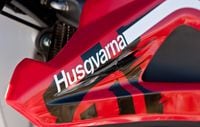
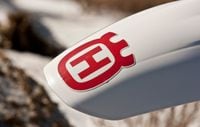
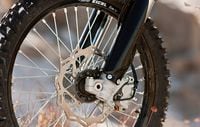
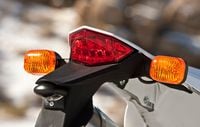
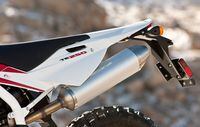
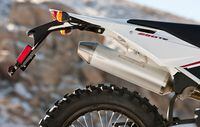
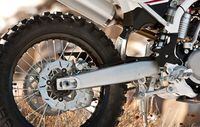
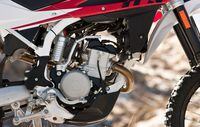
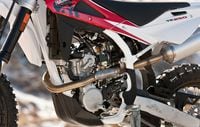
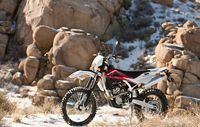
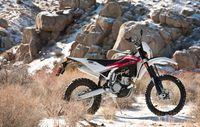
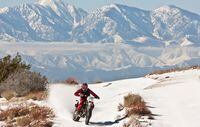
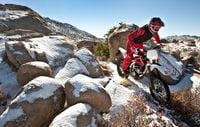
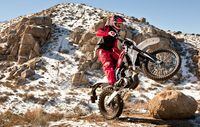

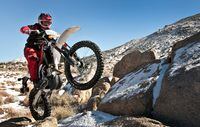
/cloudfront-us-east-1.images.arcpublishing.com/octane/RO36KTIVYZEATJW7CCB77EQHLQ.jpg)
/cloudfront-us-east-1.images.arcpublishing.com/octane/BUIUXSLF5RFRVJ3E26VRO5V2AY.jpg)
/cloudfront-us-east-1.images.arcpublishing.com/octane/EJJ2JBBSEZAWLFCRDALQOIBFVU.jpg)
/cloudfront-us-east-1.images.arcpublishing.com/octane/WVYKJFMINVFMFH37AE4OUEWVIM.jpg)
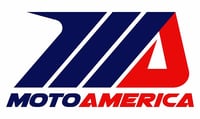
/cloudfront-us-east-1.images.arcpublishing.com/octane/JJ3MC6GNDFF5ZNYD3KD3E4EY7Y.jpg)
/cloudfront-us-east-1.images.arcpublishing.com/octane/XH2ETEU4NVGDFNQO2XT2QQS5LU.jpg)
/cloudfront-us-east-1.images.arcpublishing.com/octane/UFG652C27BDBFPK42TDAJ5CMX4.jpg)
/cloudfront-us-east-1.images.arcpublishing.com/octane/AUE3NFVRRZDSBIDVUGIYIDQNUI.jpg)
/cloudfront-us-east-1.images.arcpublishing.com/octane/LYR62CH2WNBMHJJVXVATZHOUE4.jpg)
/cloudfront-us-east-1.images.arcpublishing.com/octane/RBCTRGBQYBDK7A6XPG3HKPS7ZQ.jpg)
/cloudfront-us-east-1.images.arcpublishing.com/octane/MQXQRYMZVBCWJIRYP3HEN3SHVE.jpg)
/cloudfront-us-east-1.images.arcpublishing.com/octane/TSPODNNEWRDSVJGUCNQTDG4ADI.jpg)
/cloudfront-us-east-1.images.arcpublishing.com/octane/X5TB7BDV4BA2RPSY54ZGK27RP4.jpg)
/cloudfront-us-east-1.images.arcpublishing.com/octane/REUHOJXRDBGZ5IHBYZCCBCISPA.jpg)
/cloudfront-us-east-1.images.arcpublishing.com/octane/52LGJTCKBFEHDF7S7H4CVUIMGM.jpg)
/cloudfront-us-east-1.images.arcpublishing.com/octane/YMWAIPIPSJAOXOU3QMJMGH37OM.jpg)


/cloudfront-us-east-1.images.arcpublishing.com/octane/EJ6KZRGAYBCVXNL2PJXL37UVWQ.jpg)
/cloudfront-us-east-1.images.arcpublishing.com/octane/AAN4TI76M5H5JMUVEIGASWXBDU.jpg)
/cloudfront-us-east-1.images.arcpublishing.com/octane/P3RXD2UCPFF37CMB7CHPVKXORY.jpg)
/cloudfront-us-east-1.images.arcpublishing.com/octane/VZEG2EJI2RDFZNHLRZMU56MD3Q.jpg)
/cloudfront-us-east-1.images.arcpublishing.com/octane/GVJQO5FFOFBWNGODOBRB4FBAW4.jpg)